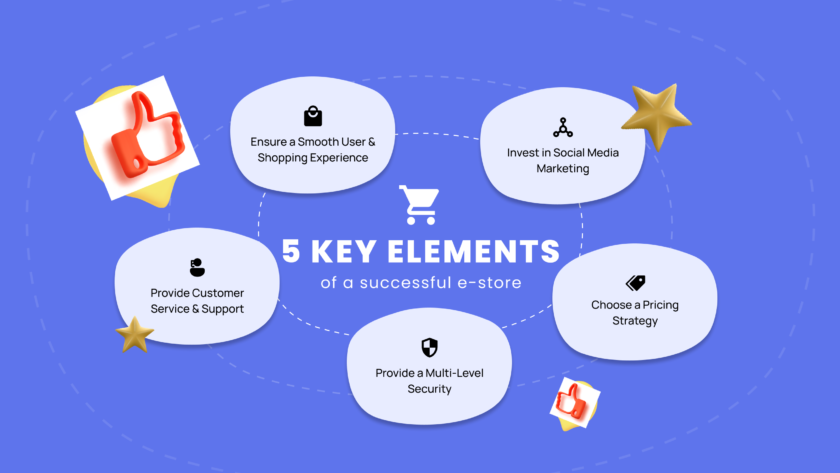In today’s competitive business environment, a successful marketing strategy is critical for gaining a competitive edge and achieving long-term success. A well-thought-out marketing strategy helps businesses connect with their target audience, build brand loyalty, increase sales, and ultimately drive growth. Whether you are a startup, a growing business, or a well-established company, understanding the key elements of a marketing strategy is essential to reaching your objectives.
This article explores the key elements that contribute to a successful marketing strategy and provides actionable insights on how to develop and implement one.
What Is a Marketing Strategy?
A marketing strategy is a comprehensive plan that outlines a company’s overall approach to promoting its products or services, increasing its market share, and achieving business goals. The strategy involves identifying target audiences, positioning the brand, setting marketing goals, and choosing the most effective tactics to achieve those goals. A well-defined strategy ensures that marketing efforts are focused, efficient, and aligned with the company’s objectives.
Key Elements of a Successful Marketing Strategy
1. Clear Marketing Objectives
A successful marketing strategy begins with clear and measurable objectives. These objectives serve as a roadmap and guide the direction of all marketing activities. Without clear goals, marketing efforts may be disjointed, ineffective, and lack focus.
Why clear objectives are important:
- They provide direction and purpose to your marketing efforts.
- They help you measure the success of your campaigns and initiatives.
- They enable better resource allocation and ensure that marketing resources are used effectively.
Examples of marketing objectives:
- Increase website traffic by 20% in the next six months.
- Grow social media following by 30% over the next quarter.
- Generate 500 new leads per month through content marketing.
- Achieve a 10% increase in sales within the next fiscal year.
How to set marketing objectives:
- Use the SMART criteria (Specific, Measurable, Achievable, Relevant, Time-bound) to set clear and actionable goals.
- Align marketing objectives with the overall business strategy and mission of the company.
2. Understanding the Target Audience
A successful marketing strategy requires a deep understanding of the target audience. Identifying who your customers are and understanding their needs, preferences, and behaviors allows you to create more tailored and effective marketing campaigns.
Why understanding your target audience is important:
- It allows you to create marketing messages that resonate with your customers.
- It helps you select the right marketing channels to reach your audience effectively.
- It enables you to personalize marketing efforts and build stronger relationships with customers.
How to understand your target audience:
- Conduct market research to gather insights about customer demographics, behaviors, and preferences.
- Develop buyer personas that represent your ideal customers. A buyer persona is a semi-fictional character based on data and research that helps define the target audience.
- Analyze customer feedback and surveys to understand what your customers value most.
3. Competitive Analysis
In order to create a successful marketing strategy, businesses must also analyze their competition. Understanding your competitors helps you identify opportunities, gaps, and threats in the market. It allows you to position your brand effectively and find ways to differentiate your products or services from those of your competitors.
Why competitive analysis is important:
- It helps you identify market trends, customer needs, and potential opportunities.
- It allows you to assess the strengths and weaknesses of your competitors, helping you avoid their mistakes and learn from their successes.
- It enables you to position your brand uniquely and highlight your competitive advantages.
How to conduct a competitive analysis:
- Identify your key competitors and analyze their products, pricing, marketing tactics, and overall business strategies.
- Conduct a SWOT analysis (Strengths, Weaknesses, Opportunities, Threats) for your business and your competitors.
- Monitor your competitors’ online presence, including their social media activity, website performance, and customer reviews.
4. Unique Selling Proposition (USP)
A key element of a successful marketing strategy is identifying your Unique Selling Proposition (USP). A USP is what sets your brand or product apart from the competition. It’s the reason why customers should choose your product or service over others in the market.
Why a USP is important:
- It helps to clearly define your brand identity.
- It gives your customers a compelling reason to buy from you.
- It differentiates your business in a crowded market and helps create brand loyalty.
How to define your USP:
- Assess what makes your product or service unique compared to competitors.
- Focus on value proposition, such as price, quality, convenience, or customer experience, that resonates with your target audience.
- Ensure your USP is communicated clearly in all your marketing efforts, from messaging to advertising.
5. Marketing Tactics and Channels
A successful marketing strategy requires the right set of tactics and channels to execute your objectives. Different marketing tactics will be effective depending on your target audience, goals, and resources. These tactics can include digital marketing, traditional advertising, content marketing, influencer partnerships, and more.
Why marketing tactics are important:
- The right tactics ensure that your message reaches your target audience in the most effective way possible.
- Different tactics can help you achieve different objectives, such as raising awareness, generating leads, or driving conversions.
- Choosing the right channels (social media, search engines, email, etc.) ensures you engage with your audience where they spend the most time.
Popular marketing tactics:
- Content marketing: Blogging, articles, videos, and infographics that educate and inform your audience while positioning your brand as an authority.
- Social media marketing: Using platforms like Instagram, Facebook, and LinkedIn to engage with customers and promote your products.
- Email marketing: Sending personalized emails to nurture leads and encourage repeat business.
- Paid advertising: Running targeted ads on platforms such as Google, Facebook, or LinkedIn to increase visibility and drive traffic.
6. Budgeting and Resource Allocation
An effective marketing strategy requires careful budgeting and resource allocation to ensure that marketing activities are financially feasible and sustainable. A clear understanding of the resources available helps businesses prioritize the most important initiatives.
Why budgeting is important:
- It ensures that you are able to execute your marketing plan without overspending or going off-budget.
- It helps you allocate resources efficiently, directing funds to the most impactful campaigns.
- It allows you to measure the return on investment (ROI) for each marketing tactic and adjust your strategy accordingly.
How to manage your marketing budget:
- Set a clear budget that aligns with your marketing objectives and the scope of your campaigns.
- Allocate funds based on the tactics and channels that are most likely to deliver results.
- Regularly track spending and adjust your strategy as needed to stay within budget while maximizing ROI.
7. Monitoring, Evaluation, and Optimization
A successful marketing strategy is not static—it should be continually monitored, evaluated, and optimized to improve performance. Regular assessment of your marketing efforts allows you to identify what’s working and what’s not, making it easier to adjust and refine your approach.
Why monitoring and evaluation are important:
- It allows you to track progress toward your marketing goals and determine if you’re on the right path.
- It helps you identify areas where your marketing efforts can be improved or optimized.
- It provides actionable insights that can inform future campaigns and marketing decisions.
How to monitor and evaluate your strategy:
- Use analytics tools (Google Analytics, social media insights, etc.) to measure key performance indicators (KPIs) like website traffic, engagement rates, conversions, and customer acquisition.
- Regularly review campaign performance and customer feedback to assess the effectiveness of your marketing activities.
- Test and refine your tactics through A/B testing and other methods to identify the most effective approaches.
8. Adaptability and Flexibility
The business and marketing landscapes are constantly changing, and a successful marketing strategy must be adaptable and flexible. Being able to pivot when necessary and respond to market trends, customer behavior, and external factors is crucial for long-term success.
Why adaptability is important:
- It allows you to stay ahead of competitors and capitalize on emerging trends.
- It enables you to respond to customer feedback and market shifts in real-time.
- It ensures that your strategy remains relevant and effective in a rapidly evolving environment.
How to stay adaptable:
- Continuously monitor industry trends and adjust your marketing tactics to capitalize on new opportunities.
- Stay in tune with customer needs and behaviors through surveys, feedback, and analytics.
- Be open to trying new marketing tactics and channels, especially as technology and consumer preferences change.
Conclusion
A successful marketing strategy is built on several key elements that align business goals with customer needs and market opportunities. By setting clear objectives, understanding your target audience, analyzing competitors, defining your unique selling proposition, and selecting the right marketing channels, you can create a comprehensive strategy that drives growth. Additionally, managing your budget, continuously evaluating performance, and remaining adaptable are essential for optimizing and evolving your approach over time.
Whether you’re just starting out or looking to refine your marketing efforts, focusing on these key elements will provide you with a solid foundation for success.




